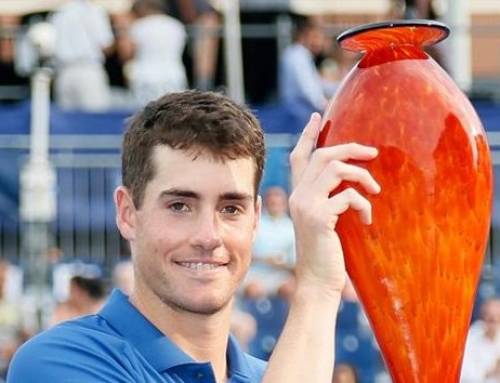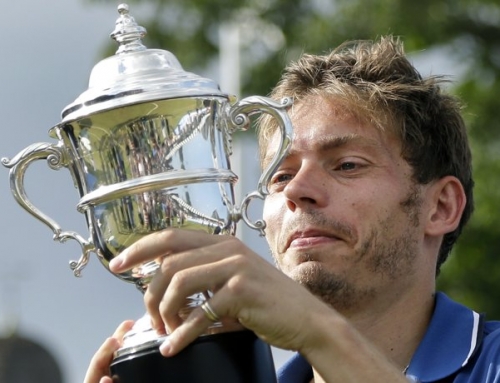 It was an improbable journey for both finalists at Delray Beach, as it often is. Two years ago, Ernests Gulbis won the event over Ivo Karlovic, and spearheaded one of his best starts in his troubled career. He would go on to beat Roger Federer and take a set off Nadal on clay which is some achievement. This year’s finalists were Kevin Anderson and Marinko Matosevic.
It was an improbable journey for both finalists at Delray Beach, as it often is. Two years ago, Ernests Gulbis won the event over Ivo Karlovic, and spearheaded one of his best starts in his troubled career. He would go on to beat Roger Federer and take a set off Nadal on clay which is some achievement. This year’s finalists were Kevin Anderson and Marinko Matosevic.
Of the two, Kevin Anderson is the more famous, and that’s in relative terms. You have to be quite the tennis enthusiast to know much about Anderson. If you group the ultra-tall players that are playing successfully in the ATP, there would only be three players: Ivo Karlovic, perhaps 6’10” or 6’11”, John Isner, an inch shorter, and Kevin Anderson, listed as 6’8″.
In the 1990’s, Mary Carillo created the phrase “big-babe tennis” to describe the play of Lindsay Davenport, Mary Pierce, Jennifer Capriati. This phrase could easily apply to the Williams sisters, Maria Sharapova, etc. She was referring to the new breed of tall, hard hitting players that was changing the landscape of women’s tennis. These players didn’t move as well as their shorter, speedier counterparts, players like Graf of Sanchez, but sometimes pace beats steadiness.
You can apply a similar phrase “big-man tennis” to these three players. Ivo has the best serve of the three. Players as highly ranked as Tsonga can’t even see his serve. It’s a testament to the skills of Federer and Nadal that they can see his serve well enough, or that they crush him on their own service games. Isner has more variety and spin on his serve, but it is nearly as effective. More importantly, Isner moves better than Karlovic. Karlovic does a masterful job of hiding his speed deficiencies. He has a huge forehand, and volleys exceptionally well for a guy his size. In the past, he really had to get to net quickly, but with a huge wingspan, he was a hard guy to pass. Isner is probably not as good a volleyer, but he is certainly quicker on court, though his speed is a liability overall, a liability strong enough to prevent him, in my mind, from reaching the top ten. He’s working on the speed, but he’ll never be Nadal or Djokovic.
Kevin Anderson almost serves as well and covers the court even better than Isner. What they all share in common is a huge serve backed up by a big forehand. “Big man” tennis is about taking a weak return and going for a winner. In the past, such players would serve and volley. All three men practice putting away floaters of all sort because long rallies are bad for these men.
Anderson’s history is very similar to Isner’s. Although Anderson is from South Africa, he played college tennis in the US for the University of Illinois while Isner played for the University of Georgia. Indeed, Anderson met his to-be wife at Illinois. He was on the tennis team, she on the golf team. Anderson’s best early performance was a finalist in 2008 at the Tennis Channel Open in Las Vegas where he beat Llodra and Isner en route to a loss to Sam Querrey who won his first title. Much like Isner, Anderson’s career has been a bit up and down as he developed his game for the tour. Last year, Anderson won his first ATP tour title in front of his home crown in Johannesburg.
Anderson again toppled Isner en route to the title. He also beat a hobbled Andy Roddick in an earlier round. Roddick, undoubtedly, will be asked questions about his retirement. Anderson’s victory over Isner was mostly about holding his nerve and serve. The two pretty much employ the same strategy. Anderson said there were times that all he was doing was walking from one side to receive to the other, but he had one good return game where he saw second serves, and that was enough for the break and the first set, and in the second, Isner got behind in the tiebreak, and it was enough for Anderson to clinch the win.
Anderson’s opponent in the final was a surprise, a Cinderella story. Marinko Matosevic is from Australia. Yes, Australia has become the haven for those leaving their home countries, whether it be Greek (a la Phillippousis) or from former Yugolavia (Tomic and Matosevic). It’s starting to become clear that as Kenyans seemed meant for marathon running, the former Yugoslavia has produced great tennis players regardless of where they end up (Milos Raonic of Canada being another such player). Matosevic is ranked 129, has never broken the top 100, is 26 years old, has been on the tour nearly 8 years, but is currently playing his best tennis.
Matosevic upset Karlovic, Gulbis, and Dudi Sela en route to the final, showing he can play big men as well as small ones. He couldn’t topple the last big man in the tournament, however, despite a game effort. In the end, Matosevic struggled on returns especially second serves. He did well to fend off break points including a 0-40 hole in the second set. He did so by hitting huge shots, often on the run. Sometimes you wonder how a guy like Matosevic finds himself in triple figures in the rankings. The guy can hit hard and seems accurate, but these days, it’s a matter of consistency. In his match against Sela, he was up breaks in the third with a comfortable lead, but found himself in a tiebreak, fighting for the victory that eventually came.
Other notes
If it weren’t for that other king of clay, David Ferrer would surely be the king of clay. There would be puns of “David and the Goliath” with this Spaniard beating players seemingly twice his height. Ferrer reached the finals of Acapulco and easily handled Fernando Verdasco, 61 62. With this win, Ferrer goes back to number 5 in the world, which he briefly relinquished to Jo-Wilfried Tsonga.
Next week, two Masters 1000 in a row. Indian Wells is a week and a half event, followed by Miami, another week and a half event. The top players are all expected to return, in particular, Rafael Nadal, who has not played since the Australian Open. Since then, Federer has won twice (Rotterdam, Dubai), Djokovic lost in the semis of Dubai, and Murray lost in the finals of Dubai.



![[Stockholm] Dimitrov wins first ATP title with 3-set victory over Ferrer](https://www.essentialtennis.com/wp-content/uploads/2013/10/20131021grigor-500x383.jpg)
![[Metz/St. Petersburg] Simon and Gulbis are champions!](https://www.essentialtennis.com/wp-content/uploads/2013/09/20130922gulbis-500x383.jpg)

